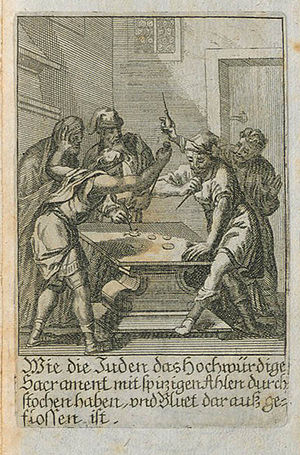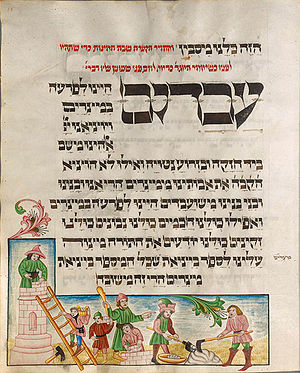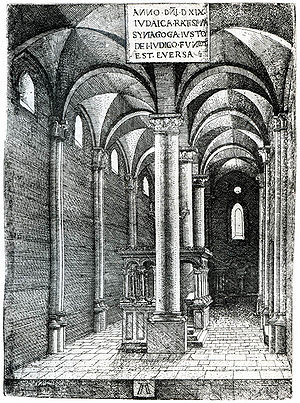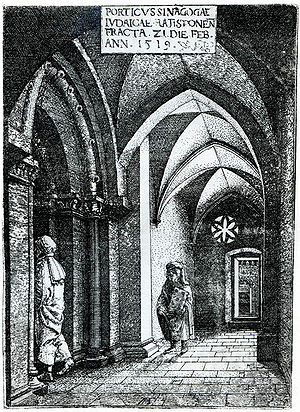



Josef Kirmeier (†)
There is reliable evidence of a Jewish community in Altbayern (i.e. the area comprising Upper and Lower Bavaria as well as the Upper Palatinate, which are the oldest parts of modern Bavaria) sporadically since the end of the 9th century, in larger amounts only since the beginning of the 11th century. Presumably a Jewish settlement had already existed since Roman times in Regensburg, the centre of Jewish life in Altbayern in the Middle Ages. A flourishing spiritual life developed there with an important Talmud school and an important rabbinical court, which was presided over in the 12th century by the great scholar Rabbi Ephraim ben Isaac (died 1175). Other Jewish communities were established in the course of the town foundings of the 13th century. Initially, Jews were mainly engaged in long-distance trade, but since the 13th century they were usually only allowed to lend money. The Bavarian dukes made early use of the imperial prerogative to protect and tax Jews. After pogroms and subsequent new settlements in the 14th century, the Jews were expelled from Bavaria in the 15th century. Under Duke Albrecht V, comprehensive settlement and transit bans were issued in the 16th century. It was not until the second half of the 17th century that a small Jewish community was able to form again in Regensburg. Jews finally played an important role as court factors in Munich in the 18th century.
Regensburg and the Beginnings of Jewish Life in Bavaria
There is no concrete evidence of the beginnings of Jewish life in Regensburg, the Jewish centre in Bavaria. Recent excavation finds even suggest a continuity of a Jewish settlement since Roman times. Until the expulsion of the Jews in 1519, the Jewish quarter was located within the old Roman fort. This site, which is located directly in the old city centre, at least suggests that Jews had been resident in Regensburg since the 6th or 7th century. The main source of income for Jews in the early days in Regensburg was long-distance trade. Their preferred settlement along the important trade routes such as the Rhine or Danube suggest this. The Raffelstetten customs regulations of 906/08 for the Danube trade mention them even before all other (Christian) merchants. Jews were also represented in the fur trade with Kiev and Russia. In the 11th century, a Jewish legal opinion mentions two Jewish merchants from Regensburg by name who were guilty of a Sabbath offence due to a broken wheel.
There is only one record of another Jewish settlement in the early Middle Ages. A diploma of Emperor Arnulf (ruled as King of Eastern Franconia 887-899, Emperor from 896) mentions the place Judaheim as property of the royal manor of Velden an der Vils in today's Lower Bavaria in 899. Later mentions of this place are missing. It is therefore not possible to identify the location. According to Wilhelm Störmer (born 1928), it could have been a settlement of Jews under the protection of this royal court, which could then have been abandoned during the time of the Hungarian invasions.
The first reliable evidence of the presence of Jews in medieval Regensburg is contained in a document issued in Rome (MGH D OII 247) by Emperor Otto II (ruled 973-983). In it he confirms to the Regensburg monastery of St. Emmeram the purchase of the property Scierstadt in the Regensburg suburb Stadtamhof, which the monastery had bought from a Jew named Samuhel. Further documentary evidence only followed in the 11th century: In 1020 a citizen of Regensburg donated three manors near the "Judenwohnungen" (Jewish homes) to the monastery of St. Emmeram.
Since then at the latest, a larger Jewish community with a synagogue, a mikvah (ritual baptismal bath), a cemetery and a rabbinical court existed in Regensburg. It was to develop into a spiritual centre of European Judaism with an important Talmud school, as numerous Jewish sources attest. For example, Rabbi Menachem ben Mechir from Bohemia, a Talmudist and liturgical poet, worked in Regensburg around 1080. In the 12th century there was an important rabbinical court in Regensburg under the leadership of Rabbi Ephraim ben Isaak (died 1175), who was considered one of the most outstanding scholars of his time and was nicknamed "Ephraim the Great from Regensburg". In 1195/96 Rabbi Jehuda ben Samuel be-Hasid (c. 1150-1217) moved from Speyer to Regensburg and taught here for 20 years. About 2,000 stories and demon tales by this author alone have been preserved in various manuscripts. Rabbi Petachja ben Jakob ha-Lavan set off from here on a world tour as early as 1174. He reached the Middle East via Poland and Mount Ararat, and travelled through Babylon and Palestine. He compiled his travel notes in a book about the Middle East; it also provides insights into the last period of the Crusader state in Palestine.
This heyday of Jewish culture in Regensburg in the first third of the 13th century also saw the construction of the new synagogue, whose early Gothic nave could accommodate around 300 people, and the purchase of a plot of land for a Jewish cemetery, which was also to serve as a burial place for the other Jewish communities in Bavaria until the end of the 14th century. Separate Jewish cemeteries in Landshut and Munich were not established until 1380 and 1416 respectively. In 1519 the Jewish cemetery in Regensburg had about 4,200 graves.
The Emergence of other Jewish Communities
Evidence of Jewish life in other Bavarian towns and cities is not found until the 13th century. A first mention of Jews in Passau is found in 1210. Jews probably settled in Landshut shortly after the city was founded in 1204. The first written reference here is in the police and trade regulations of 1256, which also regulate the sale of meat to Jews. At this time Jews were already living in Munich as well. A Jew Abraham de Municha is mentioned in a document in 1227.
Money Lending and Commodity Trade
From the 13th century on, money lending was often the only activity permitted for Jews in Central Europe. Money lending was an extremely important and indispensable activity for the chronically financially weak economy of the time. The money-lending Jew, who demanded the excessive interest rates as determined by the Christian authorities, became a significant anti-Jewish stereotype of the time.
The origins of the Jewish settlements in the Duchy of Bavaria are directly related to the town foundings in the 13th century, with the Jews playing an important role as money lenders in financing urban development. From the very beginning, the acceptance and protection of Jews was in the hands of the Bavarian dukes and not the Emperor's, who actually had the sole right to accept Jews until the Golden Bull in 1356. The Bavarian dukes, like other sovereign princes, simply made use of the royal privilege. They also had jurisdiction over the Jews. The Landfrieden (public peace) of 1244 and 1255 mainly regulated Jewish money lending and set the annual interest rate at 43%, which was at the limit of the usual interest rate, which could be as high as 173% in Austria.
Settling in Landshut and in many other towns in Upper and Lower Bavaria was already associated with many legal and economic restrictions. Land ownership and trade were now largely forbidden to Jews; they were mainly tolerated as money lenders. But individual references to Jewish trade in goods can still be found in ducal letters of protection in the second half of the 14th century. For example, a privilege granted by Duke Stephan III (ruled 1375-1413) expressly allows the Straubing (ruled 1375-1413) expressly allows the Straubing Jews to offer their goods at all places in the Duchy of Bavaria-Straubing. However, this passage is missing in the letters of protection of the other Bavarian partial duchies. In a Regensburg document, on the other hand, it was stated as early as 1238 that Regensburg Jews were only allowed to work in money lending. What remained unaffected by this was that a good part of the Jewish population continued to be active in crafts, educational and ritual services within the Jewish community.
In the course of the 13th and 14th centuries, Jews probably settled in almost all Bavarian towns and market villages in order to meet the local demand for small and very small loans, with borrowers coming from all social classes, as a preserved debt register from Straubing (Toch) shows. Jewish money lenders are therefore to be regarded as an integral part of the economic system of the time.
Anti-Judaism
The church had already intensified its measures against the Jewish population since the First Crusade (1096). Accusations had been made against Jews since the 12th century, especially in Western Europe, that they committed the ritual murder of Christian children. The accusation of desecration of the Host was added later. The increasing attempts at exclusion, such as the Jews' obligation to identify themselves (yellow spot, hat), were reflected not least in the mood of the population, mediated by the popular church . In Regensburg, for example, Jews were subjected to forced baptism.
This anti-Jewish attitude did not stop at the Bavarian Duchy either. The Munich congregation was accused of ritual murder as early as 1285. The first pogrom in Bavaria occurred here on 12 October 1285, after a Christian woman "confessed" that the Munich Jews had killed a baptised Christian child and drank his blood. An angry crowd set the synagogue on fire, killing all the Jews who had taken refuge on the first floor. Two years later the Jews who had been expelled from the town were allowed to return to Munich.
Persecution of Jews in 1338 and 1349
The first supra-regional persecution of Jewish communities occurred in the Duchy of Bavaria in the middle of the 14th century. Starting from Deggendorf, there were financially motivated murders of Jews in 20 towns in 1338. The legend of a Host miracle, which brought Deggendorf a flourishing pilgrimage for a long time, only emerged in the 15th century. The Bavarian pogroms in 1338/39 were carried out with the explicit support of the Duke of Lower Bavaria, who himself must be held responsible for the scale of the persecution.
The interest of the Bavarian dukes in the property of Jews became even more apparent in 1349 during the second great wave of persecution. In Landshut, Duke Stephan II (ruled 1347-1375) pledged the property of the Jews there in advance for 600 pounds and for the expenses he and his entourage had to incur on Shrove Tuesday, to his henchman Albrecht von Staudach, who had already been appointed to settle the accounts of Jewish property in 1338. A few weeks later Albrecht von Staudach was also commissioned to settle the accounts of Jewish property in the other Bavarian towns – in particular Munich. The Jews who had been lured back to the towns with generous privileges were murdered during the phase of the plague epidemic on the express order of the Bavarian dukes. The property went to the dukes.
Tentative Resettlement and Legal Certainty
Just a few years later, Jews were living again in Munich, Landshut and Straubing at least. They were still indispensable for a smooth economic process. The Bavarian Duke Ludwig V, „der Brandenburger“ (ruled 1349-1361) allowed the influx again in 1352. A phase of relative legal certainty that lasted almost one hundred years now began throughout Bavaria, although the communities were unable to match the number or importance of the time before the pogroms. One of the few Jews of this time known by name was the doctor and money lender Jakob von Landshut, who lived in Landshut and later in Regensburg. His treatment methods can still be found in 16th century Christian recipe collections. Jakob von Landshut was partly the personal physician to Duke Stephan III and Albrecht II (ruled 1387-1397 as governor in Lower Bavaria-Straubing), who had him come from Regensburg to Straubing after an illness in 1392.
The Expulsion of Jews in the 15th Century
At the end of the 14th century, high taxes and special levies weakened the financial capacity of the Jews, who were now increasingly facing Christian competition. The Jews' loan sums became smaller, as the preserved documents show. Borrowers were now the nobility or the dukes' servants, who in turn acted as financiers themselves or, if necessary, borrowed money from Christians. The history of the Jewish communities came to an end at a time when the Jews no longer played a significant role as money lenders. With the loss of their economic necessity, their right to live here also expired. The anti-Jewish mood in the population was repeatedly stirred up by fanatical penitential preachers. Duke Albrecht III (ruled 1438-1460) expelled the Jews from his Duchy of Bavaria-Munich a few years after his accession to power in 1442. The Lower Bavarian Duke Ludwig IX „der Reiche“ (ruled 1450-1479) followed this example in 1450 immediately after taking office. In 1478 the Jews had to leave Passau after being accused of an alleged desecration of the Host.
The End of the Regensburg Jewish Community
Bavaria's largest and most important Jewish community in Regensburg was spared the persecutions in the middle of the 14th century. Some of the Regensburg citizens, to whom the revenues from the Jewish tax were pledged, defended the community against the express will of the Bavarian rulers. The situation changed in the 15th and 16th centuries. With the economic decline of the imperial city, there was an increasing number of boycott measures and attacks by the Regensburg citizens. In 1476 a major ritual murder trial was instituted against the Jews and a total of 17 members of the Jewish community were arrested and tortured. No one but Emperor Friedrich III (ruled 1440-1493) was able to enforce their release. Only the protection by the emperor, which was expensively purchased through a special tax, saved the Jews from persecution or expulsion in the following period. The situation worsened in the early 16th century. The cathedral preacher Balthasar Hubmair (c. 1485-1528) was the main person constantly inciting against the Jewish community and demanding their expulsion from the city. When Emperor Maximilian I (ruled 1486-1519) died in January 1519 and the Jews had thus lost their patron, the city council took advantage of the opportunity. After a short discussion, the expulsion was decided and immediately implemented. The Jewish quarter was immediately demolished and a chapel dedicated to the Mother of God was built in place of the synagogue.
Settlement and Travel Bans in the Early Modern Period
After some Jews had settled on ducal Bavarian territory after the expulsion from Regensburg, Duke Albrecht V (ruled 1550-1579) decreed in a mandate in 1551 and again in the Landesordnung (general code of law) of 1553 that Jews were neither allowed to live here nor be tolerated or accepted. The Jews who had fled Regensburg to the adjacent Stadtamhof were also forced to leave the country under pressure from the Bavarian estates, who accused them of spying for the Turks, among other things. From the 17th century onwards, Jews were officially forbidden to travel through Bavaria. This escalation could be linked to the fact that at the same time Jews settled in the imperial city of Regensburg again, whose presence is documented from 1669 onwards. The most important scholar of this small community was Rabbi Isaak Alexander (1722-1799/1800), who was the first Jew to publish philosophical works in German.
Court Judaism in Munich
In the 18th century, the so-called Jewish court factors remained exempt from the general ban on residence and trade. Rich Jews were also tolerated at the electoral court in Munich, and their financing guaranteed the lavish court life, the large festivals, the supply of luxury goods and the provision of the army. In the age of absolutism, sovereigns tried to demonstrate their sovereignty through opulent displays of splendour, following the example of the French court at Versailles. In 1722, the Bavarian Elector Max II Emanuel (ruled 1675-1706, 1714-1726) took out a loan of almost one million guilders from the Jew Noe Samuel Isaac from Mergentheim to finance the wedding of his son Karl Albrecht (ruled 1726-1745 as Elector of Bavaria, 1742-1745 as Holy Roman Emperor). The strict ban on trade and residence was inevitably lifted for Noe Samuel Isaac, as it was in the following decades for Wolf Wertheimer (1709-1762) and other Jewish court factors. This resulted in a small Jewish community in Munich, whose fate was closely tied to the ruling family.
Outlook on the 19th Century
In the Judenedikt (Jews' Edict) of 1813 the general rigorous exclusion was abolished and a legal basis for Jewish life was created. However, Jews did not achieve legal equality until the integration of Bavaria into the German Reich in 1871.
References
- Richard Bauer (Hg.), Jüdisches München. Vom Mittelalter bis zur Gegenwart, München 2006.
- Michael Brenner/Renate Hoepfinger (Hg.), Die Juden in der Oberpfalz (Studien zur jüdischen Geschichte und Kultur in Bayern 2), München 2009.
- Silvia Codreanu-Windauer/Heinrich Wanderwitz, Das Regensburger Judenviertel. Geschichte und Archäologie, in: Peter Schmid (Hg.), Geschichte der Stadt Regensburg. 1. Band, Regenburg 2000, 607-633.
- Manfred Eder, Die "Deggendorfer Gnad". Entstehung und Entwicklung einer Hostienwallfahrt im Kontext von Theologie und Geschichte (Deggendorfer Archäologie und Stadtgeschichte 3), Passau 1992.
- Germania Judaica. Historisch-Topographisches Handbuch zur Geschichte der Juden im Alten Reich. [bisher 7 Teilbände]
- Josef Kirmeier, Die Juden und andere Randgruppen. Zur Frage der Randständigkeit im mittelalterlichen Landshut (Sonderveröffentlichung des Historischen Vereins für Niederbayern), Landshut 1988.
- Sebastian Schott, Die Geschichte der jüdischen Gemeinde in Regensburg im Mittelalter, in: Martin Angerer/Heinrich Wanderwitz (Hg.), Regensburg im Mittelalter. Beiträge zur Stadtgeschichte vom frühen Mittelalter bis zum Beginn der frühen Neuzeit, Regensburg 1995, 251-258.
- Siehe, der Stein schreit aus der Mauer. Geschichte und Kultur der Juden in Bayern. Eine Ausstellung veranstaltet vom Germanischen Nationalmuseum Nürnberg und vom Haus der Bayerischen Geschichte im Germanischen Nationalmuseum Nürnberg, 25.10.1988-22.1.1989. 1. Band: Katalog, Nürnberg 1988.
- Wilhelm Störmer, Judaheim beim Königshof Velden an der Vils 899. Zu zwei Kaiserurkunden für das Pfalzstift Altötting, in: Peter Fassl/Wilhelm Liebhart (Hg.), Bayern, Schwaben und das Reich. Festschrift für Pankraz Fried zum 75. Geburtstag (Augsburger Beiträge zur Landesgeschichte Bayerisch-Schwabens 11), Augsburg 2007, 27-36.
- Manfred Treml/Josef Kirmeier (Hg.), Geschichte und Kultur der Juden in Bayern. Aufsätze (Veröffentlichungen zur Bayerischen Geschichte und Kultur 17), München 1988.
- Wilhelm Volkert, Die spätmittelalterliche Judengemeinde in Regensburg, in: Dieter Henrich (Hg.), Albrecht Altdorfer und seine Zeit (Schriftenreihe der Universität Regensburg 5), Regensburg 2. Auflage 1992, 123-149.
Sources
- Raphael Strauß (Bearb.), Urkunden und Aktenstücke zur Geschichte der Juden in Regensburg 1453-1738 (Quellen und Erörterungen zur bayerischen Geschichte. Neue Folge 18), München 1960.
- Falk Wiesemann, Judaica bavarica. Neue Bibliographie zur Geschichte der Juden in Bayern, Essen 2007.
Further Research
External Links
Related Articles
- Judenschutz
- Judentum in Schwaben (bis 1800)
- Judentum (nach 1945)
- Judenverfolgungen (Spätmittelalter)
- Jüdisches Schulwesen in Bayern (1804-1918)
- Jüdisches Schulwesen in Bayern (1918/19-1945)
Cite
Josef Kirmeier, Judaism in Altbayern (until 1800), first published 08 February 2012, english version published 26 June 2023, in: Historisches Lexikon Bayerns, URL: <http://www.historisches-lexikon-bayerns.de/Lexikon/EN:Judaism_in_Altbayern_(until_1800)> (20.12.2025)
